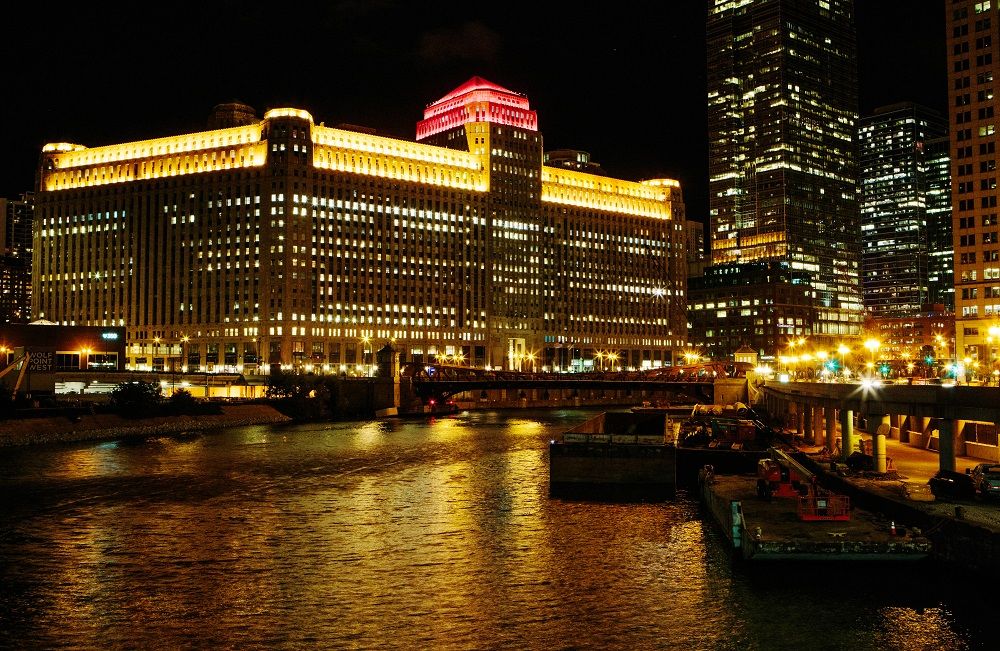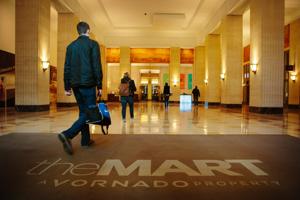Converted-warehouse space soon to house ConAgra is ironic reminder of Jobbers Canyon
POSTED: SUNDAY, OCTOBER 4, 2015 12:30 AM | UPDATED: 12:40 AM, SUN OCT 4, 2015.
It’s a riverfront icon marked by mazelike and cavernous warehouse space designed by distinguished architects as a hub for wholesalers.
Especially for those living in Omaha before 1989, the description might conjure up memories of Jobbers Canyon, the six-block historic district demolished to make way for ConAgra Foods’ suburbia-in-the-city downtown campus.
But it also describes the Fortune 500 food giant’s future base: the Merchandise Mart on the downtown banks of the Chicago River.
ConAgra announced it will relocate its global headquarters there next summer, moving into 168,000 square feet on the 13th floor of the 25-story complex.
The move, executives say, better positions ConAgra to attract the type of young talent needed to help save its embattled brands, such as Peter Pan peanut butter and Wesson oil.
In Nebraska, many are abuzz about the similarities between the piece of history ConAgra wanted razed to make way for its Omaha campus and the historic property where it’s now headed.
“The irony is incredible,” said Kristine Gerber of Restoration Exchange Omaha. “Imagine ... if they had kept those great warehouses, how cool and hip those spaces would have been.”
She said demand for converted warehouse space is a national trend, as many young workers are gravitating toward the historic industrial areas where they can work, live and be entertained.
And it’s happening more in Omaha’s downtown and north downtown, too.
Consider the nearly century-old Burlington mail terminal in the historic Rail and Commerce District. Today the structure at 950 S. 10th St. is undergoing a $25 million transformation into an office and retail hub.
New owner and anchor tenant Jon Crane of Boyd Jones Construction is hoping his future headquarters will help draw the type of talent his company needs to expand.
Just this month a Peter Kiewit Foundation-led group unveiled its initiative to buy up old industrial properties north of Cuming Street to help establish an “arts and trade” district for budding creative types. Leaders viewed that as a way to keep sharp talent in the city, in turn sharpening the city’s competitive edge.
Those Future Forward LLC properties are clustered around the Mastercraft building, yet another old warehouse converted to an incubator for fresh architects, graphic artists, branding companies, furniture-makers and more.
While Omaha has no single building that compares with the “Pentagon-like” Merchandise Mart, former city planner Steve Jensen said downtown contains several sites where resident businesses feed off each other’s work, and grow.
“It’s not like we’ve stood still” since Jobbers Canyon was demolished, along with its potential to become an urban hub of multiple uses. Jensen said Omaha has “slowly but surely” improved downtown in ways to attract millennials and others.
The most successful “innovation districts” have a presence of both entrepreneurial and established firms, he said. Places like north downtown’s Alley Poyner Macchietto Architecture co-laboratory offers numerous small firms access to bigger companies that can provide partnerships on projects and professional connections.
Young talent is attracted also to job centers near entertainment venues.
“Casual interaction is important,” he said. “That’s one of the aspects of what those young professionals are looking for — they thrive on connections with other people.”
Gerber, director of the nonprofit group dedicated to the preservation of historic structures, noted the growing Benson and Dundee districts. And the midtown Blackstone District, where professionals hired by or studying at the rapidly expanding University of Nebraska Medical Center can dine in ethnic restaurants, socialize in craft breweries or get a haircut in a trendy shop.
In Chicago at ConAgra’s new home, the Merchandise Mart already is firmly established as a home for emerging and established businesses.
Merchandise Mart was built by Marshall Field & Co. to house its wholesale division. The art deco-style building was completed in 1930 and represents the end of an era in Chicago architecture, with buildings of similar scale not being built until the 1950s, said Jen Masengarb, director of interpretation and research with the Chicago Architecture Foundation.
The Mart has 4.25 million square feet. Each floor spans two full city blocks, and still houses several showrooms for high-end furniture, fixtures and interior designers. (To compare, the now-demolished Jobbers Canyon buildings totaled more than 1.7 million square feet.)
The Merchandise Mart remains a prime venue for trade shows and conferences, but over the past three years it has seen a resurgence: Technology companies and startups are relocating there in droves.
That wave has followed the founding of 1871, a startup incubator that began in 2012 and is now home to around 400 startups. In just three years, about 900,000 square feet of space in the building have turned over to technology companies, said 1871 Chief Executive Howard Tullman.
The organization occupies about 100,000 square feet, all on one floor. That big floor plate was one reason the space was attractive in the first place. That, and its downtown location.
Tullman said it’s beneficial for any company to be located in an innovative hub such as the Mart because it results in “happy accidents, collisions and people sort of encountering each other in unexpected ways.”
“A lot of that learning can only go on in an environment where everywhere you look you’re seeing people changing the game and inventing new things,” Tullman said.
That may be true for ConAgra as well. The company already has had meetings with the Good Food Business Accelerator, located within 1871. The program, with partners such as Whole Foods and Chipotle, aims to propel fledgling businesses focused on sustainable, local food toward success, said founder Jim Slama.
“When companies like ConAgra commit to innovation, in many cases that means they’re looking in our space because our space is growing so quickly,” Slama said. “There’s interest in supply, interest in maybe doing deals with some of the companies that are part of our accelerator or our trade show. ... We’re excited about that and happy they’re coming to town.”
The building’s lobby features “dream-like” murals by Jules Guérin. At one time it had its own ZIP code. On river-boat architecture tours the foundation hosts, “You can’t ignore it. It’s so big and so prominent. And even with the much-taller buildings around it that sprung up in the last 30 years or so, it still stands out very much,” Masengarb said.
Joy Bivins, a curator with the Chicago History Museum, said the building, much like Jobbers Canyon, is a city treasure, emphasizing the importance to Chicagoans of developing and maintaining a beautiful city.
“It’s very much built with a nod to the way Chicagoans treasured then and treasure now the actual look of the city, making downtown a place that people want to come and making it beautiful and in a lot of ways very innovative,” Bivins said.
Jobbers Canyon was torn down in 1988 and 1989, over the objections of many who wanted a new ConAgra headquarters to integrate with the older structures, envisioned as redeveloped shops and offices. It remains the largest U.S. historic district ever demolished.
Could it have been Omaha’s own version of the Merchandise Mart?
Said Gerber: “That’s our history — you can never get it back.”


